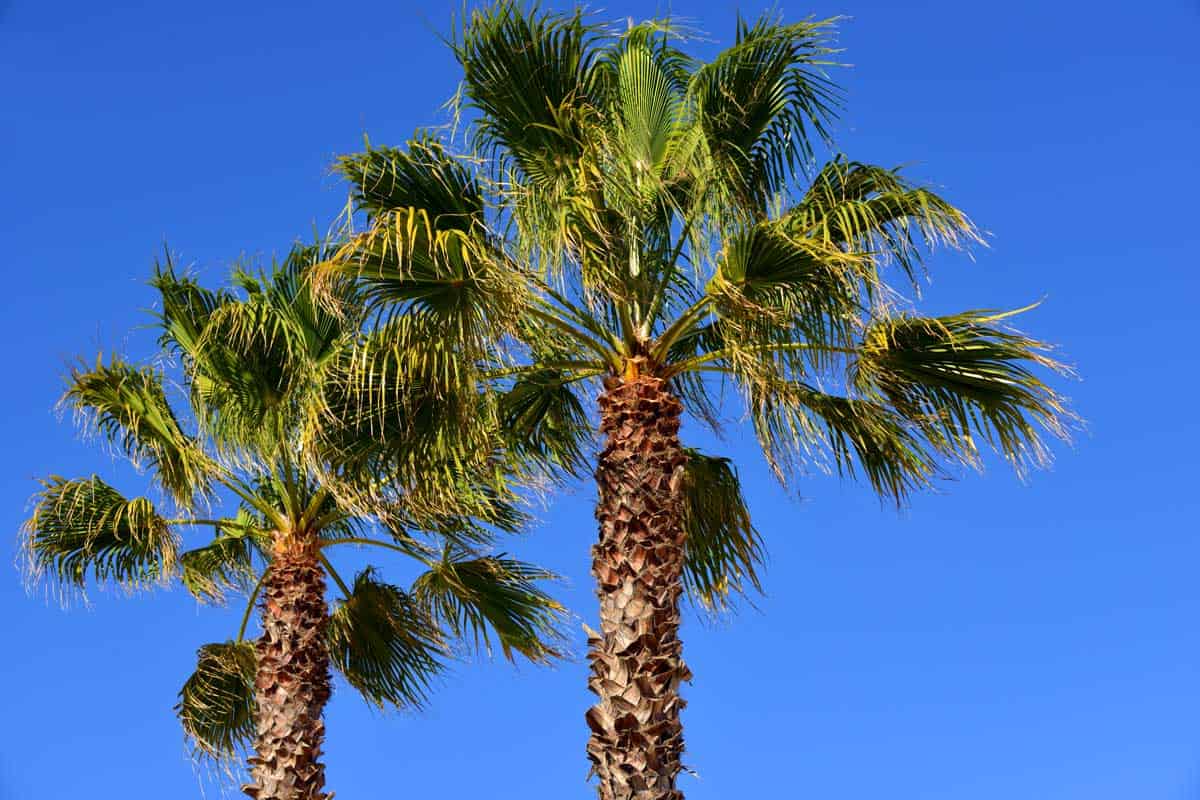 Palm trees have become synonymous with tropical and warm climates. This connection has made them a favorite among gardeners in these areas. But it often leads them to ask how fast do palm trees grow? We found an answer to provide some insight into this topic.
Palm trees have become synonymous with tropical and warm climates. This connection has made them a favorite among gardeners in these areas. But it often leads them to ask how fast do palm trees grow? We found an answer to provide some insight into this topic.
Various factors will have an impact on a palm tree's growth, such as location, how much irrigation they get, fertilizer used, and type. But the following average growth rates for these popular types should provide a better idea of what to expect:
- European Fan Palm: up to 10 inches per year
- Lady Palms: between 3 and 10 inches per year
- Foxtail Palm: more than a foot per year
- California Fan Palm: about 3 feet per year
- Mexican Fan Palm: up to 4 feet per year
- Carpentaria Palm: around 6 feet per year
- Windmill Palm: less than 8 inches per year
- King Palm: up to 2 feet per year
- Queen Palm: about 2 feet per year
- Royal Palm: between 1 and 2 feet per year
But sadly, these rates are just the averages. If you're planning on planting some palm trees, there's more info required to choose the right type. We intend to help by diving deeper into each of these common types to ensure you make the correct decision.
European Fan Palm
The European Fan Palm has become a popular choice among gardeners for a variety of reasons. It's much handier than other palms, can tolerate hard frosts, and handle cold winters. Plus, it shouldn't have any issues fitting in most gardens with its maximum height of 16 feet.
You can also count on it to grow quite slowly. At first, these palms will add about ten inches per year. This rate will slow down considerably as their age progress. Mature European Fan Palms often only add one new leaf and a couple of inches per year. These aspects make them an excellent fit for people in a less tropical climate like Texas.
Lady Palms (Rhapis)
Lady Palms, or the Rhapis species, are considered slow growers among palms. These trees are favorites for people looking to get some indoor palms. People in Japan often grew them as bonsai. Lady Palms grown outside in a suitable setting will have a growth rate of three to ten inches per year.
But indoor variations will follow a much slower timetable. In their most ideal conditions, Lady Palms are expected to grow eight feet or higher. But it can take them a long time to get there.
Foxtail Palm

The Foxtail Palm's more than a foot per year growth happens to be much faster than our previous two types. It allows these Australian palm trees to thrive in tropical areas and still tolerate coastal or cooler weather settings. As a result, they've have become commonplace in gardens within the United States' warmer regions.
Foxtail Palms are an excellent choice for an indoor option, as well. You'll need to ensure there's enough room as these trees can reach 32 feet high. In most cases, these palms will stop growing around 16 feet when indoors, but it's still a good idea to plan for the maximum.
California Fan Palm
California Fan Palms' 3 feet per year growth rate is considered rather fast among its counterparts. This rapid rate allows them to reach a height of 82 feet when mature in warm climates. It makes these palms a suitable fit in any place located between the U.S. Department of Agriculture's Plant Hardiness Zones 8 and 11.
These zones include almost everywhere in the Southern and Western parts of the United States: Texas, Florida, California, Washington, etc. But their considerable height and fast growth make it necessary to consider their growth pattern when planting. After all, the palm will end up dominating the landscape.
Mexican Fan Palm
This next type, Mexican Fan Palms, has a reputation for growing faster than almost every other palm. It can grow 4 feet per year under normal conditions within its native habitats of Mexico and Baja, California. But these trees are also commonly planted as landscape palms in Florida, Louisiana, Nevada, Arizona, and other similar areas.
In these areas, these palms are usually planted in parks, along streets, or within someone's yard to produce a more tropical look. People will often confuse them with the California Fan Palm, but its trunk size is the crucial difference. The California Fan Palm will have a wider trunk at almost two feet. Meanwhile, the Mexican Palm's will be slimmer, only being about one foot in width.
Carpentaria Palm
As noted previously, the Carpentaria Palm has the fastest growth among these popular types at 6 feet per year. This rapid growth is a key factor in allowing the Australian species to reach over 100 feet in height. But these heights are mostly reserved for the ones located in their natural rainforest habitat. Carpentaria Palms within gardens usually top out at around 65 feet.
This aspect makes these palms a favorite for people in tropical, moist areas like Florida. However, it has a sensitivity to cold that causes them to be a less than ideal fit for places like California. It might sound a little crazy, but even the slightest bit of regular cold weather can seriously hinder its growth.
Windmill Palm

The Windmill Palm's pedestrian growth rate of fewer than 8 inches per year makes it a good fit for home landscapes. You can expect a Windmill Palm to have a single, slender trunk, which gives it a compact nature. This aspect makes it capable of being grown indoors as a container plant.
If you do grow it indoors, these palms can survive almost any climate going down to zone 4 on Hardiness Zone Chart. Outdoor growers should stick to zones eight and above for peak results. It'd be wise to plant them in an area that gets some protection and shade from hot afternoon sunlight, as well.
King Palm
If you want the King Palm to keep its 2 feet per year rate, it'll need fertile soil, lots of water, and ample nutrition. But inland growers shouldn't plant these trees where they're given continuously direct sun. It would be best if you instead planted them in partial sun areas.
This situation will allow them to grow without sunburn blemishes, which makes them more beautiful. As a result, desert areas like Arizona or Nevada aren't an ideal setting for a King Palm. You do much better with a more tropical place like Hawaii or Florida.
Queen Palms
In the ideal settings, you can expect a Queen Palm to grow at its average 2 feet per year rate. These settings include areas within USDA hardiness zones 9-11: southern Nevada, southern Texas, most of Florida, coastal regions of California, and other similar locations.
These habitats will give them good soil, nutrition, and access to large amounts of water. All these factors are vital in ensuring a Queen Palm reaches its mature height of 49 feet.
Royal Palms
Royal Palms fall right in the middle of the growth rate spectrum at 1 to 2 feet per year. These palms will respond well in areas with full sun, lots of water, proper nutrition, and warm weather. However, a Royal Palm will not do well in areas with hard freezes. These trees won't take much cold below 26 to 28 degrees F. Growers who avoid planting Royals in these areas can expect them to reach anywhere between 50 to 80 feet. You also notice these palms have a noticeably large and swollen trunk base. Many people love to smack the trunk as it makes a rather delightful "watermelon sound."
How Fast Do Coconut Palm Trees Grow?

On average, you can expect a Coconut Palm Tree to reach its maximum height of 60 feet in 20 years. But these trees need two things to ensure it reaches this height, though:
- temperatures that never go below 18 degrees F
- a soil ph balance between 4.0 and 8.0
If these growth requirements are met, a Coconut Palm Tree should produce a large number of coconuts per year. It could even yield up to 75 coconuts on fertile soil. But don't expect this number year after year as it's much more likely to produce 30 or less.
How Can You Tell How Old a Palm Tree is?

In most cases, telling a tree's age will consist of counting the rings on its truck. This method doesn't work for a palm tree as these trees don't have easily identifiable markings on their trunks. But if you follow these three steps, you should find out the correct information:
Step 1
The first thing to do is research this palm tree's history. This action is made easier for trees located on a protected site like a national park. In this situation, a nearby horticulturalist or park ranger may be able to identify the palm tree's age.
Step 2
If a park ranger or horticulturalist isn't available, it's time to do the research yourself. Look up the species using resources online or at the nearby library to get a general sense of its lifespan.
Step 3
Once you've established its average lifespan, determine whether the tree has gone through a radiocarbon dating process. A national park service rep may be able to tell you whether this info is available. Radiocarbon dating will measure a tree's growth rate by analyzing it with certain chemicals.
This method is a contested one because it doesn't factor in inhibiting growth factors like disease or climate. But it's the only process capable of being used on palm trees. The information provided by it should offer a better sense of the palm tree's age.
Our article should've provided a better sense of what palm tree would fit your situation. But if you have any more questions, please let us know in our comment section. We'll answer your concerns as soon as possible.
